Table of Contents
Vietnam War is considered to be a black mark in the history of the U.S. The war took place between the communist regime of North Vietnam and South Vietnam with its major ally, the United States. The war is said to have lasted for two decades between 1954 and 1975 with heavy losses on both sides. The U.S. and South Vietnam lost the war with North Vietnam taking full control of the country by the end of it in 1975.
It is estimated that more than 58,000 U.S. troops were killed in the Vietnam war along with a million civilians on each Vietnamese side. There were casualties even on the side of Laos and Cambodia as they were indirectly involved in the war. The Cold War between the U.S. and the Soviet Union played a big role in escalating the war as the United States was completely against communism that the Soviet Union supported. Though the U.S. pulled off its troops in 1973, the war did not go down well with the American citizens considering the poor state of the American soldiers and some of the unwarranted activities in Vietnam. In 1975, North Vietnam defeated South Vietnam and the unified country came to be known as the Socialist Republic of Vietnam.
French colonialism, the Japanese invasion, and Ho Chi Minh
The Indo-China conquest of France began somewhere in 1858. Vietnam too became a colony of the French. Vietnamese people never liked the French invaders and struggled for independence. In 1919, U.S. President Woodrow Wilson advocated the independence of colonized nations. During his visit to France, a man signed a petition with other Vietnamese nationalists for the independence of Vietnam. The man was Ho Chi Minh who would later become the leader of North Vietnam. It is still not clear if that petition reached the president.
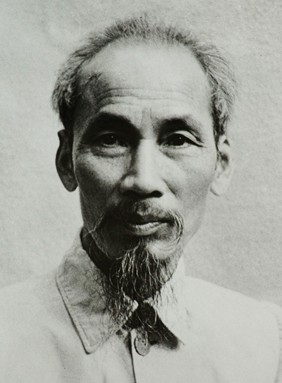
Courtesy – Wikipedia
Ho fled Vietnam in 1911 after being marked for arrest for the protest against the emperor of Vietnam. He remained in exile for the next 30 years before returning to Vietnam. Ho Chi Minh also became a communist during this time inspired by Lenin’s work.
In the 1940s during World War II, the Japanese started occupying Vietnam and collaborated with French officials in ruling the nation.
Return of Ho Chi Minh
To fight the invaders, Ho Chi Minh returned to Vietnam and created a revolutionary movement i.e. Vietnam Independence League or Viet Minh. The league was formidable and quickly turned to guerilla warfare against the Japanese. The U.S. was wary of Japan after it attacked Pearl Harbor. Ho Chi Minh contacted the U.S. for possible help against the Japanese which the U.S. agreed to. The U.S. provided Ho with the weapons for his guerilla warfare. It is said that Ho began to refer to his army as Viet American army and became good friends with the U.S. during this period.
The Japanese surrender was imminent after the atomic bombs were dropped on Hiroshima and Nagasaki. Ho called upon the people of Vietnam to take control of their country before the French could regain power. On 2 September 1945, the day the Japanese surrendered in World War II, Ho proclaimed the independence of Vietnam from France and Japan. The French did not give in to the situation and re-instated thousands of soldiers back in Vietnam. They took control of South Vietnam and attacked the North once the talks between them and Ho’s administration collapsed in 1946.
Ho’s Viet Minh retaliated by attacking the French in Hanoi in December of 1946 thus starting the First Indochina War.
When the Japanese exited Vietnam, Emperor Bao Dai became the ruler. Viet Minh however captured Hanoi in North Vietnam and claimed independence with Ho as the president. The northern region was called the Democratic Republic of Vietnam (DRV). Bao with the help of the French created the state of Vietnam in July 1949 with Saigon as the capital. While Ho wanted a single communist state, Bao and French aimed for a state with economic and cultural ties to the West.
Dien Bein Phu
Mao Zedong’s Chinese communists and the Soviets supported North Vietnam (or Viet Minh) in the Indochina war. The U.S. aided French and other anti-communist Vietnamese forces in their battle. By 1953, the U.S. and the French fought hard against Viet Minh and lost hundreds of thousands of their soldiers. The Viet Minh’s guerilla warfare proved to be costly for the French.
The French had set up a military base in Dien Bein Phu considering that any altercation with Viet Minh will attract defeat for Ho’s army. In a fierce battle, Ho’s Viet Minh surrounded Dien Bein Phu and attacked the French in 1954. The battle went on for 55 days and resulted in the surrender of the French. Almost 8000 French soldiers lost their lives in the battle. The victory of Dien Bein Phu proved to be the turning point in Vietnam’s history. French were finally leaving Vietnam.
A New Nation
After their win in Dien Bein Phu, Vietnam gained independence from France. As per the Geneva convention of 1954, a treaty was signed where Vietnam was divided into two states i.e. North and South Vietnam along the 17th parallel (17 degrees north latitude). While Ho Chi Minh was the undisputed leader of the North, Emperor Bao Dai took control of the South.
The citizens were given 300 days to relocate during the division of the nation.
In 1955, the anti-communist politician Ngo Dinh Diem removed Bao and claimed himself to be the President of the Government of the Republic of Vietnam (GVN) or South Vietnam.
Viet Cong and the start of Vietnam War
The power struggle had already started between the North and the South. Both sides wanted a unified Vietnam but not at the cost of the sacrifice of power. As the U.S. was completely against communism, it fortified its stand against North Vietnam. The U.S. and the CIA supplied weapons to the Diem’s army to fight Ho’s communists. But there was a bigger problem for Diem. There were Viet Minh sympathizers in the South whom Diem referred to as Viet Cong (Vietnamese Communists). Diem’s administration hit down on Viet Cong and even tortured and executed them. The Viet Cong, with the help of people tired of Diem’s repressive regime, began fighting and attacked government officials. By 1959, they engaged with the South Vietnamese army.
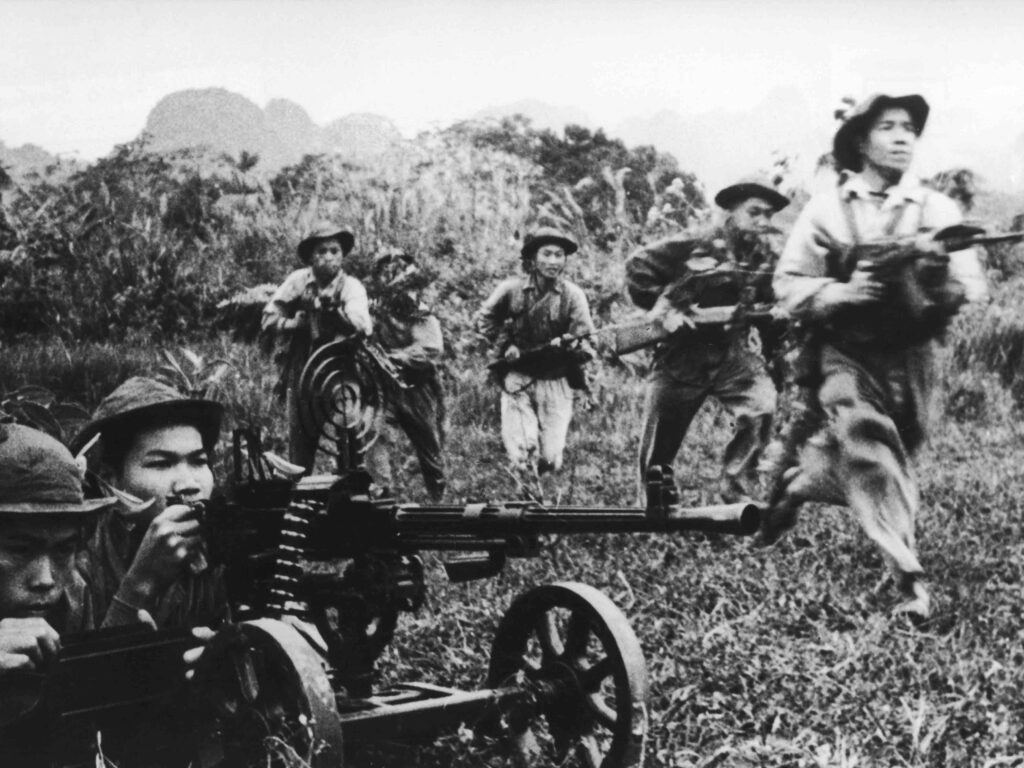
Courtesy – ThoughtCo
The opponents of Diem in South Vietnam formed what was called as National Liberation Front (NLF). The objective of the organization was to fight Diem’s regime.
John F Kennedy’s role in Vietnam War
When John F Kennedy became the president of the U.S., he was under the pressure of constraining the communist regimes around the world. He believed in the Domino Theory which stated that if a nation fell to communism, other surrounding nations will also follow the same path.
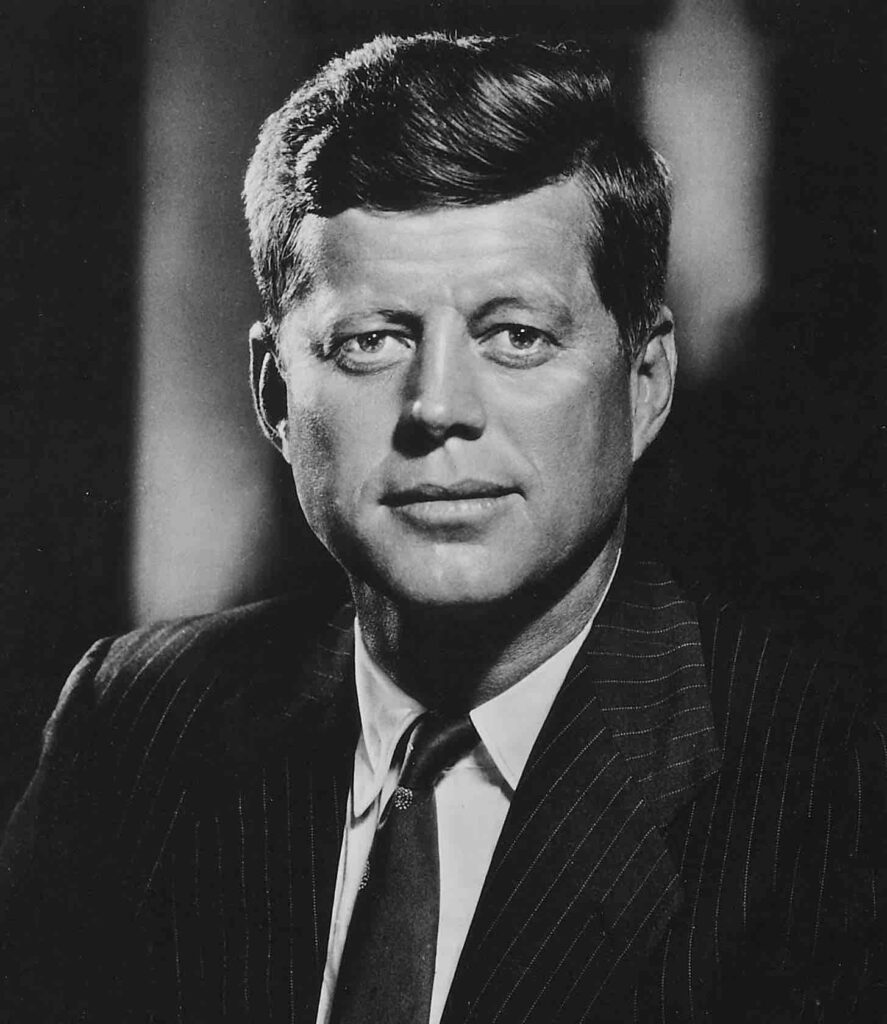
Courtesy – Wikipedia
Considering the theory, Kennedy sent elite soldiers and advisers to train the South Vietnamese army to fight against the North communist regime. Kennedy’s cabinet expressed their concern and asked Kennedy to send ground troops to fight Viet Cong, but the president refused. Kennedy increased the military funding and sent weapons and helicopters to the region. He also asked his military advisers to help South Vietnam in identifying Viet Cong hideouts and destroying the land and crops from which they fed.
Vietnam War: North Vietnam’s preparation and Diem’s repression
As the news of U.S. aid reached North Vietnam, Ho Chi Minh expected the invasion of North Vietnam to be inevitable. Communist China promised to help Viet Minh with military aid. Conscription was also introduced in North Vietnam enabling every abled man to serve in the armed forces.
On the other hand, there was an uprising brewing against Diem as his administration allowed the repression of Buddhists in the hands of Catholics.
One infamous incident was when as part of the protest, a 73-year-old Buddhist monk set himself on fire depicting what exactly was happening in South Vietnam.
Diem imposed Martial Law in the state to control any uprising. The law gave power to the authorities to arrest anyone who protested against Diem’s regime. What was seen as a symbol of democracy was now turning into a dictatorship.
With the rising atrocities, Diem’s image was not getting any better. In November 1963, in a military coup, Diem was assassinated with his brother Ngo Dinh Nhu. This happened just 3 weeks before U.S. President John F Kennedy was assassinated.
Vietnam War: Gulf of Tonkin resolution and Operation Rolling Thunder
Lyndon B. Johnson was elected as the next president of the United States after Kennedy’s assassination. Watching the instability in South Vietnam after Diem’s death and with Viet Cong as the imminent threat, Johnson increased military aid and economic support to South Vietnam.
In August 1964, a North Vietnamese torpedo squadron attacked the American warship, USS Maddox. Ho Chi Minh was shocked by the act of his naval forces. Back in Washington, the Chiefs of Staff asked for retaliation but Johnson refused to act. In a few days, another attack was suspected on a U.S. vessel by the North Vietnamese navy. The attack is still debatable today whether it happened or not. But, Johnson was convinced that it did. This time there had to be retaliation. The American air force was given orders to attack the torpedo installations of North Vietnam.
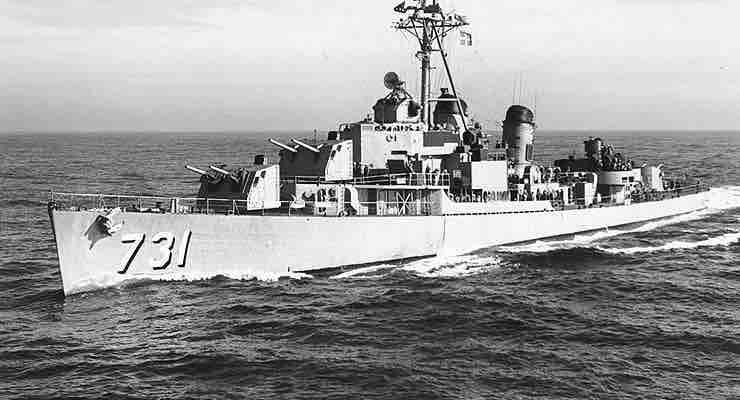
Courtesy – WordPress
Post the debatable second attack, Congress passed the Gulf of Tonkin resolution which granted the U.S. president authority to help any south-east Asian country suppressed by a communist state. The resolution also gave Johnson the power to deploy U.S. forces in Vietnam. In retaliation against the resolution, the Viet Cong guerillas shelled a U.S. airbase near Saigon. The pressure mounted on Johnson to deploy ground troops, but he refused. In another incident, Viet Cong struck a helicopter base killing 8 Americans and injuring hundreds. Later, Viet Cong also attacked a hotel leaving 23 Americans dead.
Operation Rolling Thunder
On 2 March 1965, Johnson initiated what was known as Operation Rolling Thunder. This operation aimed at systematic air raids over specific North Vietnam locations. The retaliation quickly converted into an all-out attack on North Vietnam. This was kept a secret from U.S. citizens. Johnson had widened the war. It is said that the U.S. also dropped bombs on Laos and Cambodia. This was done to restrict aid to North Vietnam via these countries.
William Westmoreland: A General with high hopes
In March 1965 itself, Johnson decided to send ground troops to Vietnam. This changed the perspective of the Vietnam War. For the Americans, the war was no more about communism but about avoiding humiliation.
At the start of 1966, almost 3,000 American troops were killed in the war. Almost 200,000 U.S. troops were stationed in Vietnam. Viet Cong had captured a large part of South Vietnam’s countryside. The Ho Chi Minh trail was an important aspect of the military supplies to North Vietnam. Americans targeted the trail but North Vietnam kept on retaliating. As days passed, the death toll of American troops rose and the American citizens grew impatient because their close ones were dying.
American General Westmoreland claimed that he could win the war in 3 years. He was in charge of the operations in South Vietnam. Westmoreland considering the situation at hand asked for additional troops from Washington which was granted even when the chances of winning were bleak.
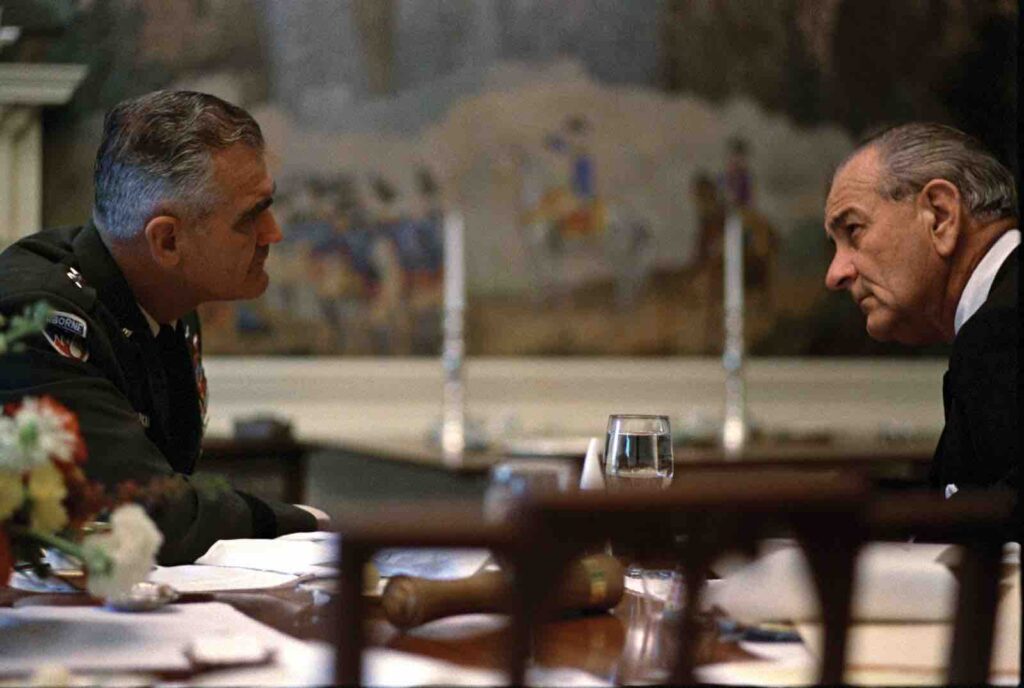
Courtesy – Britannica
One of the challenges that the American troops faced in Vietnam were the terrain. They had to deal with elephant grass, dense bushes, bamboo fields, and thick jungles. There were booby traps and land mines installed that made the job more difficult for the American troops.
Westmoreland believed in the theory of attrition i.e. to kill as many enemy troops as possible. He designated “free fire” zones in the state where the enemy was present and evacuated the civilians from those zones. The evacuation was succeeded by the heavy bombardment of these zones. Even as the casualties were increasing, the forces from both sides refused to back down. North Vietnam continued to get aid from China and the Soviet Union to strengthen its forces.
The Protests against the Vietnam War
By 1967, around 20,000 U.S. soldiers were killed and around 500,000 troops were stationed. But the primary issue was the increasing protests back in the U.S. The people were frequently told that they were winning the war, but that was not the case.
Meanwhile, there was increasing unrest among the American soldiers themselves considering the conditions they were in. They could not see a point in staying back. The war brought both physical and psychological stress to the American soldiers. The situation became worse when some soldiers attacked their senior officers and fellow soldiers. Violent protests became normal among the American soldiers both in Vietnam and back in the U.S.
The American citizens were completely shocked by the images they saw on the television and the protests became intense. The war was no more about soldiers only, even the civilians became the victims.
Vietnam War: The Tet Offensive
North Vietnam and Viet Cong kept their plans. They decided to launch targeted attacks on South Vietnamese cities including Saigon. North Vietnam knew that with Saigon lost, South Vietnam will have to surrender and the U.S. will have to withdraw its troops. The date for the attack was chosen to be 31 January 1968.
31 January was the first day of the Vietnamese lunar new year celebrations. The lunar new year is called Tet and is one of the most important festivals in Vietnam.
Ho Chi Minh decided to attack South Vietnam when it was most vulnerable. Due to Tet, many of the South Vietnamese soldiers were on vacation and did not consider any such offensive.
On 31 January, around 80,000 Viet Cong guerillas and North Vietnam soldiers under the command of General Vo Nguyen Giap attacked 100+ towns in South Vietnam and American military bases. The South Vietnamese and the American soldiers rose to the occasion and pushed back Viet Minh and Viet Cong. Johnson considered this as a decisive victory for America and South Vietnam.
Soon after the Tet offensive, Johnson decided to work on peace with North Vietnam which was welcomed by the Ho’s regime. He immediately halted the bombings in North Vietnam and initiated peace talks. South Vietnam and NLF also joined the U.S. in the talks. The peace seemed to be on the cards when suddenly South Vietnam withdrew from the talks. This destroyed everything that Johnson had hoped for. As per a rumor, Saigon stepped back because Richard Nixon promised that if he won the U.S. presidential elections, he would take a tough stand against North Vietnam and help South Vietnam reach a decent conclusion.
Amid heavy protests, Richard Nixon became the next president of the United States.
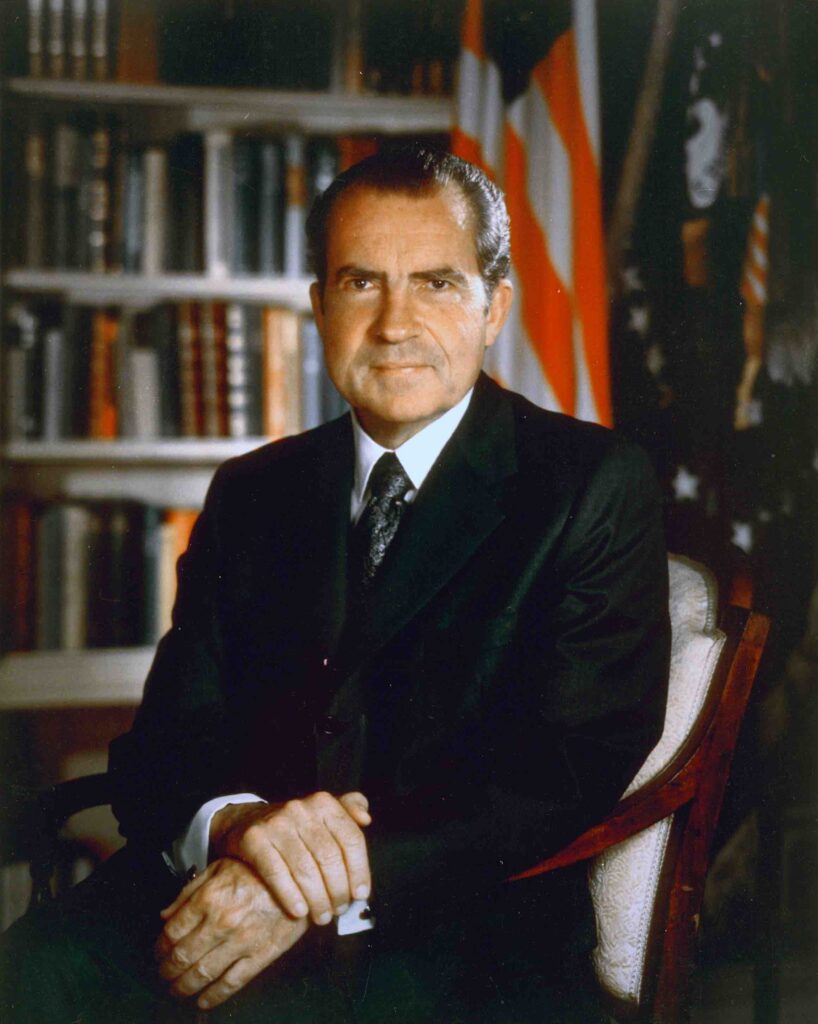
Courtesy – Wikipedia
Vietnamization and the beginning of withdrawal
Even after the Tet offensive, Westmoreland asked for more troops to be deployed. This came as a shock for the U.S. people who were repeatedly told that the war was on the brink of conclusion and that the U.S. and South Vietnam would come out victorious.
When Richard Nixon took office, more than 35,000 U.S. troops were killed. To reduce American casualties, Nixon decided to introduce the policy of Vietnamization. As per the policy, the South Vietnam forces were to take more responsibilities in the operations as American ground troops would be withdrawn. More importance would be given to air raids and the American soldiers would train the South Vietnamese soldiers.
Nixon though continued to offer peace talks, North Vietnam insisted on the complete withdrawal of the U.S. forces. This didn’t happen. On the other hand, South Vietnamese troops were apprehensive of the fact that if the U.S. couldn’t win the war with half a million of its troops, how could South Vietnam achieve that all by itself?
On 2 September 1969, Ho Chi Minh died, disappointed that he could not see Vietnam united.
Vietnam War: My Lai Massacre & Protests
The anti-war sentiments grew within the U.S. when the citizens came to know that the American soldiers butchered around 500 innocent people in the town of My Lai. The intensity of the protests increased in the U.S. In November 1969, a huge peaceful protest happened in Washington D.C. where almost 200,000+ Americans took part. The demand was simple – withdrawal of the U.S. forces from Vietnam.
There were protests on the college campuses too. 4 students were killed in protests at Kent State University and another 2 were killed at the Jackson State University. The Americans were divided as far as the government was concerned. Some thought of the Vietnam War as an unwanted display of power while others supported the government.
Vietnam War: Peace talks and American troops withdrawal
In 1972, North Vietnam agreed to negotiations after a failed offensive on the South. North Vietnamese and American representatives drafted a peace agreement but it was rejected by South Vietnam.
With peace talks and negotiations at a stalemate, Nixon decided to go ahead with the offensive. He ordered air raids around Hanoi which were called the Christmas Bombings. Over a thousand civilians were killed in the attack. The bombings were criticized by leaders and people around the world.
In January 1973, the U.S. and North Vietnam agreed to the peace deal. On March 29, 1973, the last American ground troops left South Vietnam. Only a few Marines were left behind.
Vietnam War: Fall of Saigon and creation of Socialist Republic of Vietnam
North and South Vietnam continued with the war though. Nixon promised South Vietnam of assisting in case North Vietnam posed a threat to them. But, in August 1974, Nixon resigned and the Congress was in no mood to help South Vietnam. The U.S. cut South Vietnam’s military funding in half. The conditions went from bad to worse when the South Vietnamese soldiers began leaving their military units.
North Vietnam seized the opportunity and defeated the South Vietnamese army at every point because it had the upper edge. People from South Vietnam began to flee to escape the wrath of North Vietnam. South Vietnamese President Nguyen Van Thieu resigned amid the crisis.
On April 29, 1975, the DRV forces began their offensive to capture Saigon. On April 30, Saigon fell and North Vietnam claimed victory.
New Vietnam
After 30 years of war, over 2 million Vietnamese deaths, and millions of refugees, Vietnam united under a single communist authority. The war destroyed Vietnam’s economy and infrastructure and it did not seem to come back in shape anytime sooner.
In 1976, the war-affected Vietnam became the Socialist Republic of Vietnam. In new Vietnam, agriculture was collectivized, capitalism was abolished, and the industry was nationalized. This made the conditions worse. The standard of living fell, and the people starved. Most people fled Vietnam to other countries. There was a complete economic breakdown.
It was only by 1986 that the country’s economy came back into shape. The trade and diplomatic relations between the U.S. and Vietnam started in 1990.
It was estimated that the U.S. invested around $120 billion during the war between 1965-73.
The veterans of the war faced criticism after returning to the U.S. The opinions were divided. Some criticized them for losing the war, while others criticized them for killing innocent civilians. In any case, they had to live with the consequences.
America honored its war victims by erecting The Vietnam Veterans Memorial which was unveiled in 1982 in Washington D.C. On it is inscribed the names of 58,320 American soldiers who lost their lives in the war.
FAQs
The Vietnam War supposedly started in 1954 as per the historians, though many believe that the roots of the war were sown many years before.
North Vietnam won the Vietnam war after the U.S. exited the war leaving South Vietnam to tackle the situation. The victory was claimed on 30 April 1975.
Ho Chi Minh was a Vietnam nationalist who raised his voice against the rule of the French in Vietnam. He later became the leader of North Vietnam during the Vietnam war.
Vietnam war ended on April 30, 1975, after the surrender of South Vietnam to North Vietnam forces.
Richard Nixon, the then President of the U.S., introduced the policy of Vietnamization where the American troops would be slowly withdrawn from the war and South Vietnam forces will take the authority and the forefront.
The U.S. was criticized for the Vietnam war because of its lack of strategy in the war. Later, America withdrew keeping the South Vietnamese army in a mess. Though the U.S. played a major role in the war siding with South Vietnam, the lack of policies created chaos among the American masses.
Many American soldiers were killed during the war and the people were given the wrong information that they were winning the war when in fact they were not. The war brought annoyance among the people and they criticized the U.S. government and the military for their tactics. Most people and even soldiers realized that there was no point in keeping up with the war as it was going nowhere.
CURATED & WRITTEN BY
AYUSH PANDYA
(AUTHOR – THE UNPRECEDENTED CULT)